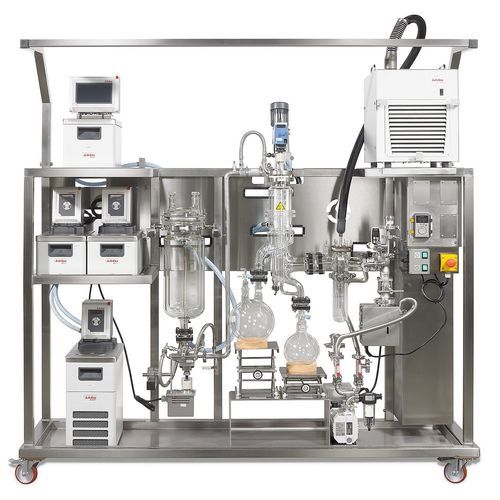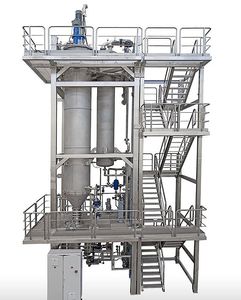
Laboratory evaporator DSL5thin-filmwiped filmshort path
Add to favorites
Compare this product
Characteristics
- Type
- thin-film, wiped film, short path
- Laboratory/process
- laboratory
- Applications
- for liquids
- Other characteristics
- explosion-proof, with stand
Description
LABORATORY UNITS
Our laboratory units, Thin Film evaporators DSL and Short Path evaporators KDL, are oftentimes used in research and development laboratories,
where they are used for a variety of distillation tasks. They have a modular design and allow flexible adaptation to a wide variety of tasks.
With throughputs of only approx. 100 grams per hour, our smallest laboratory units are especially suitable for applications where often only small quantities of a product mixture is available.
Our larger laboratory systems, can also be used for small-volume production of up to 10 kilograms per hour.
The core components of all our laboratory systems are made of borosilicate glass. This is chemically inert and also resistant to corrosive media.
A major advantage of a glass plant is that it allows direct observation of the distillation process.
Does the distillation is going well or is there possible foaming to be observed, other unwanted changes or even decomposition of the product?
These are important findings that can also be gained during feasibility tests in our innovation centre for the development of your processes.
Characteristic features
• Capacity: 0.2kg/h to 10kg/h
• Heated surface: 0.01m² to 0.3m²
• Max. Heating temperature: 350°C
• (medium: thermal oil)
• Operation pressure: 0.001mbar to 1mbar
• (Short Path distillator), 1mbar to 100mbar
• (Thin Film or Wiped Film evaporator)
• Material: borosilicate glass
Catalogs
KDL 5 AS LABORATORY PLANT
1 Pages
Related Searches
- Laboratory evaporator
- Liquid evaporator
- Vacuum distiller
- Thin-film evaporator
- Distiller for the chemical industry
- Explosion-proof evaporator
- Distillation unit for the pharmaceutical industry
- Food product distillation unit
- Short path evaporator
- Wiped film evaporator
- Short path distiller
- Essential oil distillation unit
*Prices are pre-tax. They exclude delivery charges and customs duties and do not include additional charges for installation or activation options. Prices are indicative only and may vary by country, with changes to the cost of raw materials and exchange rates.






